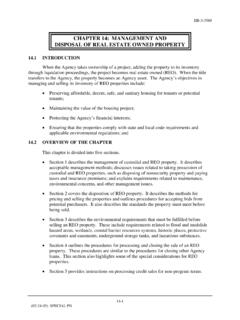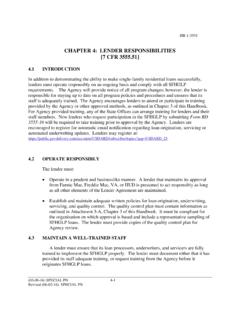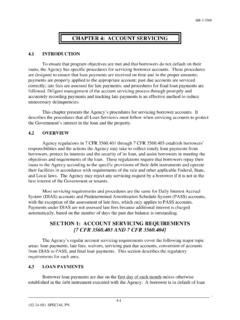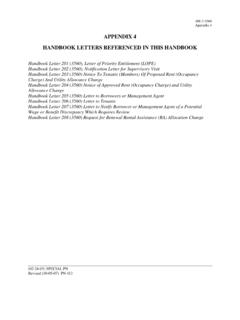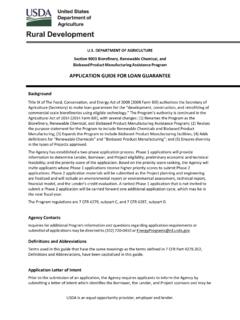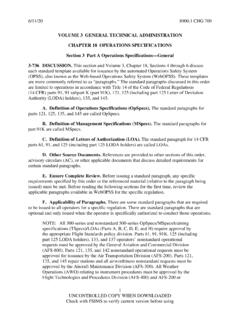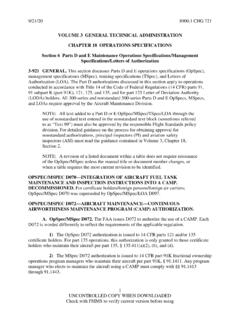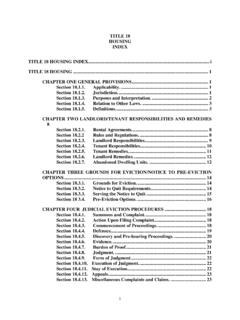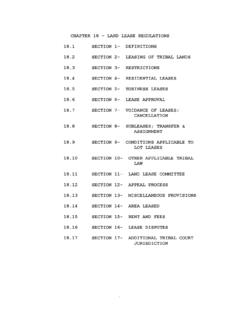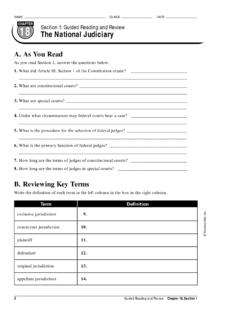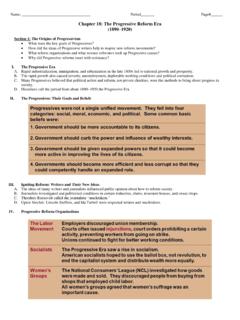Transcription of CHAPTER 18: SERVICING NON-PERFORMING LOANS – …
1 HB-1-3555 18-1 (03-09-16) SPECIAL PN (03-09-16) SPECIAL PN Revised (07-02-18) PN 514 CHAPTER 18: SERVICING NON-PERFORMING LOANS ACCOUNTS with repayment PROBLEMS 7 CFR INTRODUCTION The servicer is required to employ an experienced and knowledgeable staff, follow accepted industry SERVICING practices, and maintain a SERVICING platform that keeps records of all SERVICING actions. Servicers are fully responsible for complying with this CHAPTER regardless of any sub- SERVICING arrangements. Appendix 8 of this Handbook outlines the servicer s responsibility to report to the Agency all delinquent LOANS and quarterly portfolio reports through EDI. When a loan becomes past due, the servicer must take prompt and aggressive action to help the borrower bring the account current.
2 The servicer should work closely with the borrower to resolve any delinquency as early as possible to prevent further collection activity. In cases where the borrower is unable or unwilling to repay the loan , the servicer must take prompt action to liquidate the loan , either by encouraging the borrower to liquidate voluntarily through foreclosure. section 1 of this CHAPTER states the minimum actions the servicer is required to take and bring past-due accounts current. section 2 of this CHAPTER describes various alternatives to foreclosure that the servicer will pursue, including traditional and special loan SERVICING actions to follow. section 3 of this CHAPTER describes the requirements within the foreclosure process. section 4 provides servicers with requirements when a property is located in a county, parish or municipality that has been declared by the President of the United States to be a major disaster area where federal aid in the form of individual assistance is being made available.
3 section 1: COLLECTION EFFORTS AND REQUIREMENTS [7 CFR ] OVERVIEW A goal of the Agency is to provide a borrower the maximum opportunity to remain a successful homeowner. Consequently, the servicer should approach loan SERVICING as a preventive as well as a curative action. Prompt counseling and follow-up with a borrower who is late with a monthly payment, especially the first payment, is key to enhancing the likelihood of success. The servicer should identify any SERVICING actions that could aid a borrower who is experiencing repayment problems. MINIMUM REQUIREMENTS [7 CFR ] When a borrower s account becomes past due, the servicer must, at a minimum, take the collection efforts described below. Each delinquency should be treated individually using collection techniques that fit the individual circumstances.
4 Additionally, the HB-1-3555 18-2 Agency recommends making personal contact with a delinquent borrower until the delinquency is cured. Debt collection efforts may be suspended when applicable laws restrict creditor action to collect a debt or take action. An example that may be a violation of an applicable law is if the commencement of debtor s bankruptcy case occurs. A. Initial Contact The servicer must attempt to make verbal or written contact with the borrower on or before the day an account becomes 20 days past due. The servicer must send a letter to the borrower if unable to reach the borrower by telephone. This contact must solicit enough information to evaluate the borrower s ability to cure the default and to help determine the additional SERVICING actions to take.
5 At a minimum, the servicer must attempt to establish and document the following: The borrower s current mailing address and telephone number; The reason for the default; Whether the reason is temporary or long-term; The borrower s attitude toward the debt; The borrower s present income and employment status; The borrower s current monthly expenses and debt obligations; and A realistic and satisfactory arrangement for curing the default. B. Notify Credit Repository The servicer must provide an accurate and complete file of the status of mortgages in its Agency-guaranteed loan portfolio to a minimum of three credit repositories each month with the goal of avoiding disputes that could arise from inaccurate or inconsistent reporting.
6 C. Send Certified Letter to the Borrower Before an account becomes 60 days past due and the borrower has not made arrangements for payment, the servicer must send a certified letter to the borrower. The letter should emphasize the importance of meeting the debt obligation, negative impact of non- repayment on the borrower s credit history, and request an interview with the borrower for the purpose of resolving the past due account and avoiding foreclosure. The information required at the initial contact should be requested in the certified letter if initial contact was not made. HB-1-3555 (03-09-16)SPECIAL PN 18-3 Revised (07-02-18) PN 514 D. Inspect the Property Before a delinquent account becomes 60 days past due and before initiating a liquidation action, the servicer must take the following steps: Occupancy-Assess the physical condition of the property and determine the occupancy status of the dwelling and use reasonable judgement to determine if the property is vacant or abandoned.
7 For all inspections, servicers shall be required to document the general condition of the property and identify any actions required to adequately protect and preserve the property. Abandoned property- In all cases, the servicer shall take all necessary actions to protect the property from waste, damage, and vandalism. The servicer should document the SERVICING file outlining the determination using indicators such as property condition, posted for sale signs, presence of personal property or vehicles, yard condition, last known mailing address, or absence of a power meter. If the loan is delinquent, expedite foreclosure by referring the loan for acceleration within 15 days of the date of the inspection report confirming the property was abandoned.
8 Additional guidance regarding management methods and activities of custodial properties can be found at Paragraph of Chapter19 of this Handbook. Inspections-The servicer should make an inspection of the mortgaged property at least monthly to verify occupancy and ensure the property is being adequately maintained. Generally, curbside inspections are inadequate for making these determinations and are acceptable to the Agency only if there is danger to the inspector or there are legal restrictions preventing access to the property. Inspection records must be retained in the mortgage file, and address at a minimum, the condition of the property, occupancy status and any necessary repairs to protect an abandoned property, the date of inspection, and who performed the inspection.
9 E. Proceed with Liquidation When the account becomes 90 days past due and the borrower has been non-responsive or has declined all available foreclosure prevention options, the servicer must initiate liquidation proceedings by accelerating the loan and, if necessary, foreclose as long as any applicable notice and waiting period under state law is met. DOCUMENTATION REQUIREMENTS AND PENALTIES [7 CFR ] A. Collection Records The servicer must maintain records of all collection efforts and must make them available upon request by the Agency. These records may either be in the form of HB-1-3555 18-4 SERVICING logs and/or copies of letters sent to the borrower. The records must indicate the following: Reason for the default; Date(s) and content of written notification(s) to the borrower; Dates and results of personal contacts with the borrower to resolve the debt both by telephone and/or in-person; Dates and documentation of property inspections; and Date liquidation action was initiated.
10 B. Grace Period for Completing Collection Action The servicer is required to take all collection actions within the time frames described in Paragraph of this CHAPTER . However, the Agency may allow a grace period of five business days for completing each required collection action. Thus, no penalty will be assessed if the servicer takes the required action before the end of the grace period. C. Penalties for Failure to Fulfill Collection Obligations If the servicer fails to take the minimum collection efforts in Paragraph and experiences a loss on the loan , the loss claim amount will be reduced. The Agency may apply the following penalties for a servicer s failure to take the required collection actions. These penalties are described in greater detail in CHAPTER 20 and Appendix 9 of this Handbook and include the grace period offered by the Agency as noted in Paragraph B above.
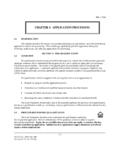
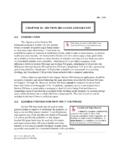
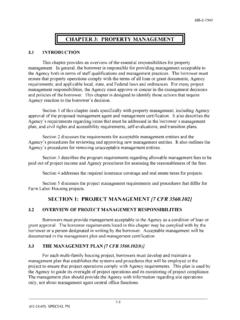
![CHAPTER 14: FUNDING [Official Agency Use Only]](/cache/preview/5/1/5/b/5/3/5/c/thumb-515b535cec62fd2bb25fbb788ef1c7a2.jpg)
